This article analyzes intermedial1 artworks in the form of “poetry objects”, which combine poetic text with various forms of visual art – sculpture, painting, photography – to form hybrid literary-visual constructs. These works have oblique relationships to the book (the normal vehicle for poetry). In functional terms, though not in appearance, such “poetry objects” are closer to the poetry book than is the case with “abstract or conceptual book art”, as defined by Garrett Stewart, in which “the idea of the codex survives its use” (2011, xiv). Poetry objects are readable as well as viewable, whereas abstract book art is essentially sculpture which incorporates or mimics the material form of the book; the quality of being readable has definitely been displaced by the status of art objects. Poetry objects are on the outer edge of the artists’ books form, defined by Johanna Drucker as “a book created as an original work of art […] which interrogates the formal means of its realization and production with its thematic or aesthetic issues” (2004, 14). Poetry objects are not books, but they do, to varying extents, interrogate the same set of formal, thematic and aesthetic issues as artists’ books. Furthermore, like many artists’ books, they reflexively interrogate readability along with the material form of the book. Drucker recognizes the blurred boundaries of the category of “artists’ book”, and what I am here calling “book objects” could be included within her broad characterization of the artists’ book; nevertheless, they are distinct in that their physical form is clearly not that of a book2.
The works I will discuss were commissioned as part of the Poetry Beyond Text project (2009-11). This project, based at the Universities of Dundee and Kent, was funded by the UK Arts and Humanities Research Council as part of its programme, Beyond Text: Performances, Sounds, Images, Objects, and combined literary criticism, experimental psychology and practice-based research to study hybrid poetic-visual forms and practices. One element of the research was the commissioning of works involving collaborations between poets and artists, some working together for the first time. The commissions took a wide range of material and genre forms: artists’ books, sculptures, screen-based and virtual-reality digital works, films, photographs, concrete and visual poems. The current discussion, however, focuses on three “poetry objects” which invite (but in some instances also resist) several modes of engagement, including the reading of text as poetry, looking at an object or image, and touching (a haptic engagement with texture and shape, processes of unfolding or extracting).
Deryn Rees-Jones and Marion Smith, Vivam
Vivam, a collaboration between poet Deryn Rees-Jones and sculptor Marion Smith, is a poetry-sculpture. This hybrid form, which has antecedents in the ancient tradition of memorial inscriptions on monuments, is now relatively common in exhibited installations. Vivam, however, is distinctive in being an intricately constructed, highly integrated, portable, poetic-sculpted object. It takes the form of a wooden box with an opening lid.
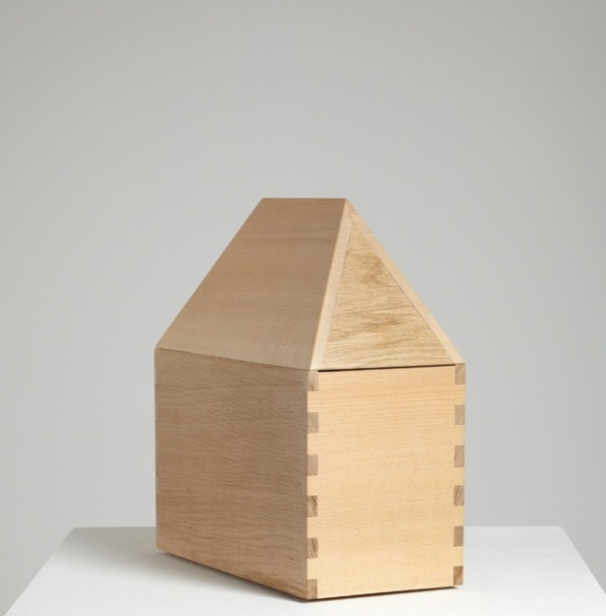
When the lid is closed (Fig. 1), the form suggests a house, or a reliquary (a container for sacred relics), and offers to the viewer (who is not yet a reader) a sensuous pleasure in its beautifully crafted joints and smooth surfaces. In the closed state it is textually “blank” and enigmatic. When the lid is opened, five glass plates or “leaves” framed in wood are revealed, sitting vertically within the box (Fig. 2).
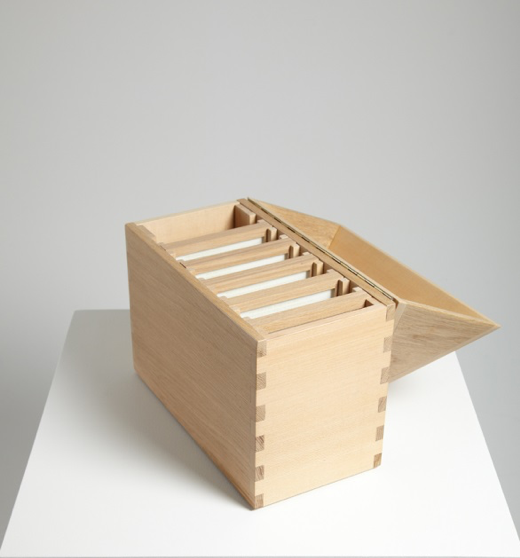
These leaves can be individually lifted and located in alternative slots so as to stack at progressive heights (Fig. 3).
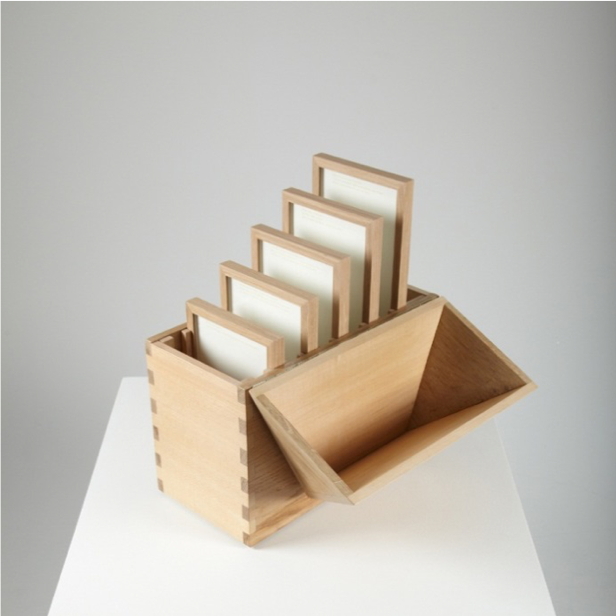
The initial location of the leaves of glass, and the vertical process of lifting them, suggest combs in a beehive. When in stacked position, the leaves are also quite architectural, suggestive of skyscrapers or a staircase, as well as a series of framed artworks. Rees-Jones’s poem is printed in pale green type on cream card under the five leaves of glass, one stanza on each. The words occupy about one tenth of each framed card, while the rest is blank.
Vivam
Difficult love, for not being here,
I call you everything: space on my pillow, rag-a-bones,
and the secret name that only we share.
Now sleep avoids me,
lets the radio’s words
dull the music of silence. Hollow my holla.
How can you be by not being there?
Bees, lime-blossom, bean-flower. I dream I have become a tree
and you’re tethered somehow in that blue wood
where death is alive, though I’m not alone,
where shyly in the starlight, our mouths become leaves
for you’re a tree too. And the dream makes no sound,
like the lazy blink
of an ancient god, and your last breath is mine, being there.
The words are quite small, and faint, and occupy only the upper part of each leaf: they feel like an elusive presence. The reading process is fraught with challenges and obstacles. First, if one encounters the work in a gallery (another effect of intermedial hybridity is to change the contexts of “reading”), one may be unsure whether one is allowed to touch it. If it is closed, gallery visitors rarely open it without specific encouragement. If it is open, they still don’t know whether it is acceptable to lift out the leaves in order to read the poem. Even if they do, the faint print, and the fact that one has to read across a series of separate, quite heavy “leaves”, carefully lifting and replacing each, generates an unfamiliar mode of reading. Nevertheless, one is also tempted to read, both by the beauty and sensuous qualities of the object, and by the lure of the hidden or secret. The smoothness of the wood, especially where the two woods are so perfectly jointed, invites a caress, a haptic experience. The mobility of the glass leaves invites a narrative reordering or disruption. Reading and rearrangement seem invited but potentially transgressive acts on the part of the viewer. In the stacked position, the stanzas of the poem either sink or rise in sequence, suggesting a descent into the underworld and a return; a process of death and resurrection.
The title of the work is the final word of Ovid’s 1st-century BCE collection of stories, Metamorphoses and is the Latin verb, “live”. It occurs in the phrase “live to all eternity”, as part of a resounding assertion of the permanence of art (a version of the well-known classical tag, “ars longa, vita brevis”):
My work is complete: a work which neither Jove’s anger, nor fire nor sword shall destroy, nor yet the gnawing tooth of time… Wherever Roman power extends over the lands Rome has subdued, people will read my verse… I shall live to all eternity, immortalized by fame. (Ovid 1955, 357)
Despite the jarring note of imperial triumphalism in Ovid, the themes of death and what survives it are significant for Rees-Jones’s poem, which is a very personal one – a poem of bereavement, addressed to the poet’s dead husband. It thus belongs to that curious, though very familiar, form of poetry which is addressed to someone other than the reader, and which draws on shared knowledge not known to the reader (especially that of lovers) – a circumstance referenced explicitly here in the third line (“the secret name that only we share”). This suggests at least one dimension to the rhetoric of secrecy and non-disclosure in the final work. The poem also draws on Coleridge’s poem “This Lime Tree Bower”, in which the natural world, especially the world of trees, offers consolation for the poet’s sense of abandonment, and hinted anticipation of death. But Rees-Jones’s poem alludes most specifically to the story of Baucis and Philemon in Ovid: a virtuous married couple whose hospitality to two strangers (the gods Jupiter and Mercury in disguise) is rewarded by their preservation from a devastating flood, and the granting of their wish, to live together and die at the same moment, when they are turned into trees, an oak and a lime (linden)3. Whereas in the ending of Metamorphoses, the brevity of human life is redeemed by the longevity of art, in the story of Baucis and Philemon, it is redeemed (symbolically) by the persistence of nature: the long fidelity and virtue of the couple being perpetuated in the form of the two trees growing side by side. But they are also silenced by death, represented in the slightly horrific image of the bark growing over their lips as they just manage to say goodbye to each other. The story informs Rees-Jones’ poem obliquely, in the dream in which she and her husband become trees, and seem to share their “last breath”. Like Ovid’s story, the poem seems poised between consolation and horror. The poignant contrast with the source is that Baucis and Philemon are granted their request “that death may carry us off together at the same instant, so that I may never see my wife’s funeral, and she may never have to bury me” (1955, 198), whereas the poet has had to face her husband’s funeral.
The sculptural poem-object is made of oak and lime (male and female in Ovid), the two trees into which Baucis and Philemon are transformed, and woods which have very different qualities as working materials4. It thus materialises the symbolism of the story: the close-fitting joints of the box and lid marry the two woods together with great precision. We may note that one of the pairs of terms in which innovation in poetry has been debated is that of the “closed” and “open” poem, as in the well-known essay “The Rejection of Closure” by the US experimental poet Lyn Hejinian:
a “closed text” is one in which all the elements of the work are directed toward a single reading of it. Each element confirms that reading and delivers the text from any lurking ambiguity. In the “open text”, meanwhile, all the elements of the work are maximally excited; here it is because ideas and things exceed (without deserting) argument that they have taken into the dimension of the work. ([1983] 1996, pp. 27-28)
A visual pun is created by Vivam: a “poem” which is closed, but can be opened; or open, but can be closed, tempting us to consider possible relations between material and semantic ambiguity. Furthermore, the metaphor of the box has been used in this context, from Yeats’s “a poem comes right with a click like a closing box” (1940, 24) to what Barbara Herrnstein Smith has termed William Carlos Williams’s “semiscriptural” opposition to “[t]he closed poem – the poem that clicks like a box” (1968, 237). Openness and closure are vexed terms in modernist and contemporary poetics, applied variously to the poet’s experience of completing the work, to the internal development of the poem, and to the reader’s relationship to the poem. Polemically, open and closed poems may be opposed terms, but most detailed critical analysis reveals blurring and mutual interdependence between the two. Most useful in the present context is Jacob Edmond’s proposal of a “dialectic [or “interplay”] between openness and closure” (Edmond 2009, pp. 244-245). In this light, Vivam’s material structure enacts (or invites the viewer / reader to enact) a form of meta-reflection on the processes of reading and interpretation through the literal opening and closing of a box.
In the records of the collaboration between the poet and sculptor, it is mentioned that the two considered using watermarks on paper, Morse code, or braille for the text. They also considered the possibility of a work in which only the title word, “Vivam”, was visible, and one in which the poem, or paper, was hidden in the sculpture and had to be sought. The poet commented:
One of the images that I love is that sense of the husband and wife just having time to say goodbye before their mouths become trunks and leaves. I like the idea of things being seen and unseen. And secrets! (Rees-Jones, s. d.)
So the elusive, partly hidden quality of the poetic text seems to be associated with ideas of secrecy and privacy, and a contrary incitement to discovery; with ideas of the sacred and the withheld; with private languages. The poem is one of voice, but the combined work does not so much “speak” as contain and displace speech, render it as whisper. The sensuous materiality of the poem-object in a sense shields the privacy of the poem’s mourning, by physically containing it. Nevertheless, the material and semantic aspects of the work function in parallel. Both invite and yet resist engagement: the poem by expressing private feelings, the object by inviting haptic engagement which a gallery setting hardly authorises. Images of all the commissioned works can be found on the project website at http://www.poetrybeyondtext.org/gallery.html.
Deryn Rees-Jones and Alice Maher, The Wren’s Egg
The poetic text again has an elusive quality in another collaboration undertaken by Rees-Jones, this time with the Irish artist Alice Maher: a poem-photograph entitled The Wren’s Egg (Fig. 4).
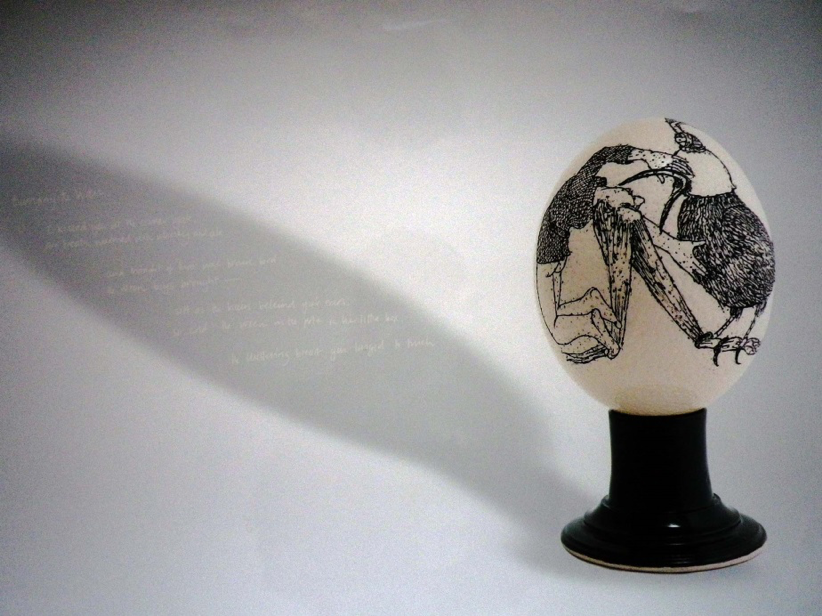
In the photograph, the viewer is likely to see first a very large egg with an ink drawing upon its surface, and only then to notice the long shadow it casts and, very faintly, the lines of the poetic text:
Burying the Wren
I kissed you at the corner gate,
our breath warmed with whisky and ale
and thought of that shy brown bird
the wren boys brought:
soft as the hairs behind your ears –
so cold – the wren on the pole in her little box –
the fluttering breast you longed to touch.
The poet explains the background of the poem thus:
The wren boys [in Ireland] are mummers of sorts. On the 26th of December, wearing old clothes or straw suits, and wearing masks or with cork-blackened faces, they move from house to house carrying a pole tied with holly and ribbons, on the top of which is a little basket or box. Inside, supposedly, is a wren. A real bird? A dead bird? Any bird at all? This little bird carried a huge charge for me, in part because of… the role birds play as intermediaries between the living and the dead. (Roberts 2011, 25)
She describes her motivation for writing the poem as follows:
I wanted to set up a dynamic between the bird and the woman in the poem. Whose fluttering breast is being touched, the bird’s or the woman’s? Who is cold? Who wants to touch who or what? There’s also a funny sort of mixing and mingling between the I and the He and the bird… In some ways I think of it as a half sonnet. In the service of its design it is without its second part; perhaps it is the equivalent of a piece of paper folding. (Roberts 2011, pp. 25-26)
Here the idea of folded paper – as used in many artists’ books – plays a role in the creative process, but not in the final form of the work, which is very different. Again there is a suggestion of concealment. The poet describes “Burying the Wren” as a “little piece of origami” and “a little box”, and compares it to “the thought experiment devised by the physicist Erwin Schrodinger in the 1930s’ in which “it is only when we open the box that we can know one way or another”. (Roberts 2011, 26)
On the surface of the egg sculpture a line drawing depicts a large bird, nearly of human size, seemingly wrestling with a human figure; although there is a balletic quality to the posture of the figure, the open beak and the hand over the bird’s eyes suggest violent struggle (Fig. 5).
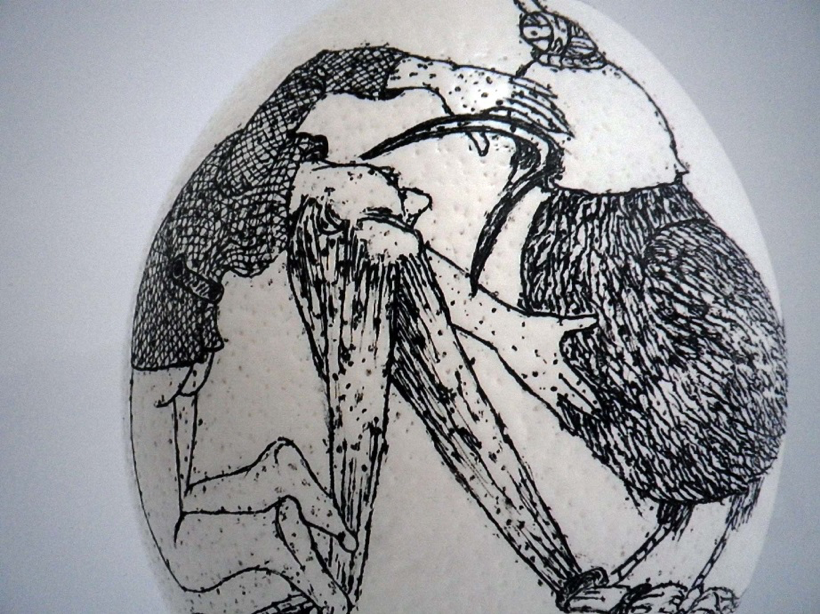
The image seems in oblique relation to the poem. The fierce bird in the drawing is very unlike the “shy” wren of the poem, and the violence of the image is in sharp contrast to the mood of reminiscent sensuality in the text. This obliqueness of relation between image and text is itself represented by the spatial structure within the photograph, with the poem’s text placed in the slanting shadow of the egg. In both poem and image, however, there is a pairing of bird and human and, despite the sense of aggression in the drawing, the person’s hand is laid on the breast of the bird. Associations of life and death are present in each: the “wren on her pole in the little box” may be dead, which casts an ominous shadow over the passionate, living bodies of the lovers, who are kissing, breathing and touching (might the shadow of the egg be the shadow of death?). The line “the fluttering breast you longed to touch” brings into juxtaposition the passionate, beating heart of the poet and an image of the smooth, still-perfect feathered breast of a bird which has just died. The drawing, because it represents extremity of movement (especially in the contortion of the figure), draws attention to its own freezing of time into a static moment. One might hear and see faint echoes of John Keats’s Romantic poem “Ode on a Grecian Urn”, especially since the image on a curved surface makes the egg somewhat reminiscent of a Greek Attic vase, while the breath and passion of the poem recalls Keats’s lines:
More happy love, more happy, happy love! For ever warm and still to be enjoyed, For ever panting, and for ever young - All breathing human passion far above (1970, 535)
But the relation is an ironic one; Rees-Jones poem is very much about “breathing human passion”; it is the drawing which suggests by its material form the transformation of living love into “Cold Pastoral”, while its content displaces passion with a deathly struggle, or even a struggle with death. Thus the status of art as a lasting memorial of passing human experience is referenced, while the more temporal, and more expressive qualities of the lyric poem are implicitly contrasted with the spatial impersonality of the image. At the same time, the slightly funereal associations of the bird in a box are echoed by the egg on its black pedestal. At an earlier stage of the collaboration, it was intended for the poem to be inside the egg, which would have made it completely invisible and inaccessible, encased like the wren in the Wren Boys’ performance. It is indeterminate whether the photograph constitutes the work, or is rather a record of it. The way in which the poem lies in the shadow, and is more or less illegible (although published separately), seems superficially a demotion of the poetic text, overshadowed by the sculptural object and its strong drawing. The Wren’s Egg engages with space in a manner which is both that of a picture and that of a sculpture, as defined by Martin Seel:
Unlike a sculpture’s space, the space of a picture is not part of the real space of its appearance; it emerges solely from the difference between the pictorial object and pictorial presentation… the appearance of a sculpture is the appearance of an entity in space. The appearance of a picture is an occurrence on the surface of the pictorial object. (Seel 2005, 162)
As a final photograph The Wren’s Egg is a picture on a flat pictorial object, but the object-text relation which that photograph records articulates an unfamiliar relationship between an image on a curved surface (the egg) and a text on a flat horizontal surface. Sculptural spatial relations are evoked, but not made available to the viewer other than through their representation on a flat plane. The normally flat, non-object plane upon which a poem is inscribed is presented in a represented three-dimensional space. We might wish to handle the egg, but it is unavailable.
Douglas and Gillies, Poempondscroll
Artist Helen Douglas and poet Valerie Gillies created a photographic-poetic scroll, the title of which presents the merging of literary genre (poem), object of representation (pond) and material embodiment (scroll). It uses photographs of a pond in the Scottish Borders, near to the artist’s home. Poempondscroll is a horizontal scroll over five meters long, in which poetic text combines with images of the pond, including light, ripples, tadpoles and reflections of reeds or grasses. There is an effect of words submerging, becoming tadpoles, and re-emerging. (Fig. 6).
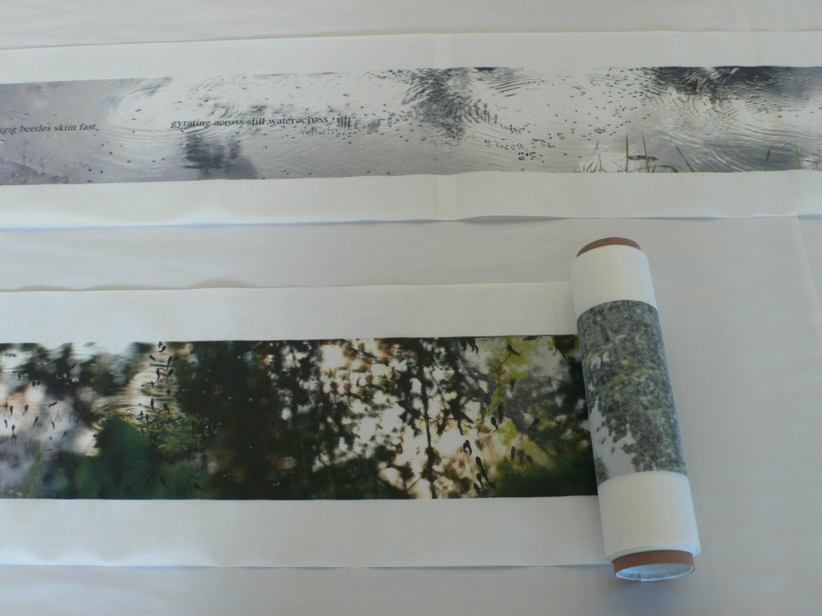
The poetic text consists primarily of fragments of description, some relatively literal (“tadpoles swim up for air”; “the valley wind blows”; “deep round clear clean”); others ascribing qualities to the creatures of the pond (“the damselfly loves the pool”; “the frog knows this world”). There are also phrases which seem addressed to the human viewer of the pool or the work (“at evening, lean over”; “to hold a moon in your ….”). In some instances, as in the last phrase quoted, words become faint and disappear into invisibility as they merge into patches of dark or light. The overall effect of the text is an evocation of natural beauty and animal life in a mood of reflective calm. In this instance, the material form of the work has obvious and distinguished antecedents. Historically, the scroll precedes the codex as a surface for recording of images, symbols and writing. One of the great hybrid collaborative works of the modernist period, La prose du Transsibérien et de la Petite Jehanne de France, by Blaise Cendrars and Sonia Delaunay-Terk, though it folds rather than rolls, takes the form of a long sheet, a little over two metres long5. William Blake, a crucial predecessor for most poetic-visual hybrids, attributed symbolic meanings to book and scroll through their representation in his works. In W.J.T. Mitchell’s interpretation, the scroll, for Blake, signifies writing as prophecy, and the book signifies writing as law, a binary with which Mitchell associates a series of hierarchical distinctions:
In the context of romantic textual ideology, the book is the symbol of modern rationalist writing and the cultural economy of mechanical reproduction, while the scroll is the emblem of ancient, revealed wisdom, imagination, and cultural economy of handcrafted, individually expressive artifacts. (Mitchell 1994, 132)
Poempondscroll certainly places itself in the Romantic tradition through its celebration of the natural world, its imagery of reflection (a standard Romantic trope for the reciprocal relationship between human and nature) and its blending of text and image so as to imply the quest for a “language of nature”, which would reintegrate human cultural sign systems into organic processes. To that extent, it partakes of the prophetic. So this Romantic inheritance which Mitchell describes would provide one possible form of the relation of Poempondscroll to the book: a certain distance, defined by the associations of the scroll form. Certainly, the descriptions of the collaborative process by the creators of the work, which stress the importance of the fine Chinese paper (collected during the artist’s travels) as a source of inspiration, place it in the tradition of “handcrafted, individually expressive artifacts’; a quality which it has in common with both Vivam and The Wren’s Egg. Poempondscroll shares with Blake’s engravings the integration of poetic text and images, since the words are within the photograph of the pond and merge with it (rather than forming separate visual elements). Gillies also indicates that the idea of the scroll derived in part from the circular shape of the pond which it depicts, which also prompted “the idea of [poetic] couplets encircling the creatures who live in it” (Roberts 2011, 33), thus making a connection with the land in the material and poetic forms. Poempondscroll, like Vivam, invites a physical manipulation – in this case rolling and unrolling – which may be unavailable or risky (in this case because of space or fragility). This is something of a relatively common feature of book-objects (especially, but not only, those made of paper): that their form invites handling which their uniqueness (or near-uniqueness) makes problematic. Unless Poempondscroll is fully unrolled, there is a partial visibility, but its implications are less those of concealment and secrecy than of the endlessness of both nature and language, and of the flow of each.
Conclusion
These are works whose status as material objects in three-dimensional space transgresses the normal protocols for reading poetry, and, in the case of The Wren’s Egg and poempondscroll, they also make problematic the spatial characteristics of picture, sculpture and text. Vivam seems, in one sense, to be clearly a sculpture, but its interiority (particularly the interiority of the text), its use of “leaves”, and the need to manipulate its parts in order to read, make it equally clearly a form of artists’ book. Poempondscroll has a material form which both positions it against the book and constitutes a form of sculptural object. All three works are fully intermedial, integrating rather than merely juxtaposing, word, image and material form. Nevertheless, the experience of the viewer or reader is crucially formed by transgressions of the normal processes of reading poetry and viewing pictures or sculpture. The intermediality of the works harmonizes diverse genres and modes within an aesthetic conception but does not erase the sense of transgression. Can they be regarded as reworkings of the book? Clearly they have ancestors other than the book: poetic inscriptions on sculptures or artifacts, and poetic text on scrolls, have venerable histories. In this sense The Wren’s Egg is the most genre-transgressive, since the photograph of a poem and a sculpture together is hardly an established form. Nevertheless, insofar as the book has been the dominant mode of presentation for poetry (along with performance) for several centuries, the idea of the book is an inevitable presence in these works.
Bibliography
Drucker, Johanna. 2004. The Century of Artists’ Books, 2nd edition. New York: Granary Books.
Edmond, Jabob. 2009. « The Closures of the Open Text: Lyn Hejinian’s “Paradise Found” ». Contemporary Literature 50 (2):240‑72.
Hejinian, Lyn. (1983) 1996. « The Rejection of Closure ». In Onward: Contemporary Poetry & Poetics, édité par Peter Baker. New York: Peter Lang.
Keats, John. 1970. "Ode on a Grecian Urn", in The Complete Poems. Édité par Miriam Allott. New York: Longman.
Mitchell, W.J.T. 1994. Picture Theory, Essays on Verbal and Visual Representation. Chicago: University of Chicago Press.
Ovid. 1955. Metamorphoses, book XV. Traduit par Mary M. Innes. Harmondsworth: Penguin Books.
Rees-Jones, Deryn. s. d. « Private correspondance ». Unpublished.
Roberts, Andrew Michael. 2011. Poetry Beyond Text: Vision, Text and Cognition. Dundee: Poetry Beyond Text. http://www.poetrybeyondtext.org/maher-rees-jones.html.
Seel, Martin. 2005. Aesthetics of Appearing. Traduit par John Farrell. Stanford: Stanford UP.
Smith, Barbara Herrnstein. 1968. Poetic Closure: A Study of How Poems End. Chicago; London: University of Chicago Press.
Stewart, Garrett. 2011. Bookworks: Medium to Object to Concept to Art. Chicago; London: University of Chicago Press.
Yeats, William Butler. 1940. Letters on Poetry from W.B. Yeats to Dorothy Wellesley. London: Oxford University Press.
There are extensive typologies of intermediality available; for the present discussion Dick Higgins’s conception of intermedia from 1966 is adequate: as works “in which the materials of various more established art forms are ‘conceptually fused’ rather than merely juxtaposed”. I would add two conditions: first, the contrast between more and less established art forms no longer seems very relevant, if it ever was; and, second, conceptual fusing though crucial, can be highly debatable.↩
Drucker discusses “book-like objects or book sculptures”, but keeps these “just beyond the zone of artists’ books” on the grounds that “there is enough to deal with in trying to understand what a book is when it functions as a book, when it provides a reading or viewing experience sequenced into a finite space of text and or images” (2004, 10).↩
The story ends with the moral “Whom the gods love are gods themselves, and those who have worshipped should be worshipped too.” (Ovid 1955, 198)↩
Smith, the sculptor of the work, notes that lime is traditionally used for fine carving, as by Grinling Gibbons (private correspondence).↩
La prose has a considerable integration of paint and text, with blocks of colour overlaying sections of text, although the general arrangement is binary, with painting on the left and poem on the right.↩
